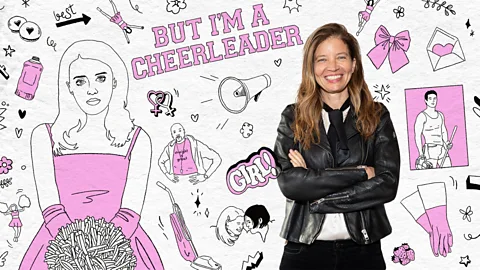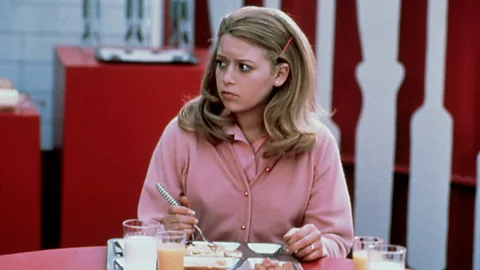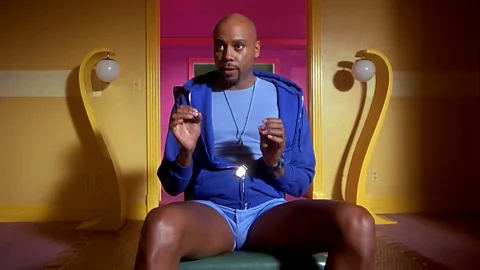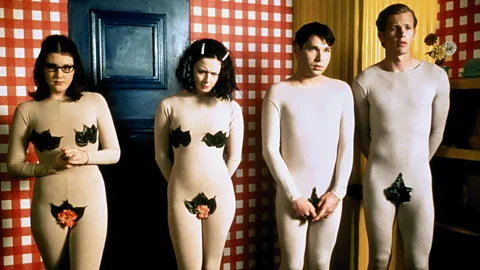'I wanted to make a gay Clueless': Jamie Babbit on how her lesbian comedy But I'm a Cheerleader became a cult classic
 Emmanuel Lafont/.Getty Images
Emmanuel Lafont/.Getty ImagesIn 1999, this unlikely rom-com set at a conversion therapy camp and starring Natasha Lyonne was hated by critics. But it's since been recognised as both groundbreaking and hilarious.
Jamie Babbit's audacious feature debut But I'm A Cheerleader is a bona fide LGBTQ+ cult classic. The satirical romantic comedy premiered at the Toronto Film Festival 25 years ago, in September 1999, and though it was critically panned initially, it has since been deservedly recognised for its pioneering lesbian representation, among other things. Babbit's film delivered a campy but heartfelt dismantling of gender stereotypes and the obscene practice of conversion therapy.
Indeed, with its wit, flair and refusal to bow to convention, it was a key film in Hollywood's wider lesbian awakening during the 1990s, when more rounded and sympathetic lesbian characters were gradually beginning to emerge. Babbit says she came up with the concept of the film from a desire to fill a void. "I was a young femme lesbian in my twenties, and I didn't see any movies about lesbians that felt like a movie for me," she tells the BBC. "I wanted to tell a story of a femme lesbian who rescues a butch lesbian, using her femme powers of cheerleading to do that."
 Alamy
AlamyBut I'm a Cheerleader follows all-American teenage pom-pom shaker Megan Bloomfield, played by a then-19-year-old Natasha Lyonne, who is left bewildered when her conservative parents send her to a reparative conversion therapy camp called True Directions. She arrives, pom-poms still in hand, the joke being that she is the last to know that her vegetarianism and adoration of singer-songwriter Melissa Etheridge all point to her latent lesbianism.
Subverting your typical coming-of-age tale, where teenage characters go on a voyage of emotional discovery, the film sees Megan and her fellow gay teens through an eyebrow-raising five-step programme to repress their feelings and "conquer" their "homosexual tendencies". However, this is evidently all in vain, after Megan is partnered with rebellious lesbian Graham (Clea DuVall), a spunky young woman who sees right through the institution's glossy, gleeful veneer.
Lesbian representation
At the time of But I’m a Cheerleader's release, when the likes of Fight Club and The Matrix dominated the box office and gay marriage was not yet legal anywhere in the US, queer cinema was tentatively entering the mainstream. However, I'm A Cheerleader stood out from many LGBTQ+ films of the time in one key respect – it was unabashedly funny.
Culture Shifters
Culture Shifters is an interview series in which high-profile creatives reflect on a work of theirs which made a big impact on the world. Read more articles from the series here.
"In the nineties, a lot of gay friends of mine were dying of AIDS," Babbit explains, of her decision to make such a light film about serious subject matter. "Comedy was important because if you don't laugh, you're crying." Emerging from the epidemic, iconic queer films of the time were often distinctly morbid – think of Peter Jackson's 1994 Heavenly Creatures, about two teenage girls turned murderers, and Kimberly Peirce’s 1999 Boys Don’t Cry, about the brutal killing of trans man Brandon Teena. Then there was Lana and Lilly Wachowski’s 1997 thriller Bound, which depicted lesbians in an underground crime world and persistently under threat.
By contrast, Babbit wanted to create a story to uplift her community in the wake of such sorrow on and off screen. But I’m A Cheerleader's light campiness has arguably led to a more playful and triumphant strain of queer cinema which includes such films as Angela Robinson's 2004 parodic lesbian rom-com D.E.B.S, about the relationship of a spy in training and her nemesis, and more recently Emma Seligman's 2023 Bottoms, which follows a sapphic high school fight club. The film's conversion camp setting is ripe for traumatic ponderings, yet But I'm A Cheerleader is effervescently joyous.
 Alamy
AlamyTake the scene where the teens are tasked with identifying the "root" of their homosexuality: their self-diagnoses range from blaming the fact that they've attended an all-girls boarding school to their mother being married in trousers, each explanation more ridiculous than the last. The film gets yet more hilarious as camp counsellors Mary, played by Cathy Moriarty, and "formerly gay" Mike, played by RuPaul a decade before RuPaul's Drag Race, lead baby-rearing lessons for the girls and wood-chopping for the boys respectively – both of which are inadvertently packed with sexual innuendo.
"I was always gravitating towards comedy, but not John Waters' shock, gross-out. I wanted a sweet romance fairy tale that's also biting," Babbit says. But I'm A Cheerleader not only celebrates the comradeship between the teens as a group, the range of whom reflect the diverse shades of lesbianism, but also focuses in on the developing love story between Megan and Graham – one which plays out with awkwardness, but not, importantly, fear from either party. In the darkness, Babbit finds hope. She says she wanted to reflect the irony that conversion therapy camps "can be a conduit for gay people from small towns to meet each other and fall in love. I was trying to be optimistic about a deeply screwed-up situation."
Conversion therapy
It's not only the prominent and warming lesbian representation that makes But I'm A Cheerleader a standout amongst nineties LGBTQ+ cinema, but the film's trenchant takedown of conversion therapy, the practice of trying to change an individual's sexual orientation or gender identity. A 2022 report from The Trevor Project estimated that 508,892 LGBTQ+ youths in the US were at risk of being subjected to conversion therapy in 2021. While such recent films as The Miseducation of Cameron Post and Boy Erased, both released in 2018, consider conversion therapy with sombre gravity and depict the violent results of such practices, decades earlier But I'm A Cheerleader broke boundaries by approaching the topic with satire.
The film looks at how among other things, conversion therapy can be founded on reinforcing outdated gender stereotypes. At True Directions, "they tell you if you like pink and Barbie you're ladylike, and if you do dishes, clean and cook, you'll be straight," Babbit explains. "I wanted to show how artificial that was."
This artificiality is reflected in But I'm A Cheerleader's whole aesthetic, with its high-camp costumes and production design. At True Directions, teens are dressed in polyester, gendered uniforms and the technicolour artifice stretches to the girls' sleeping quarters where there are brightly kitsch, plastic pink sheets. As Babbit says, she wanted the camp to look like "a Barbie Dreamhouse because it's so plastic, so fake and not organic".
 Alamy
AlamyThe film reaches its apex with the teenagers' final test before they graduate as "straight": simulated heterosexual sex. Those who have got this far are dressed in full-body nude leotards with Adam and Eve-esque leaves and flowers over their genitals. Paired with a member of the opposite sex, they must lie together in a constructed reality of hetero sex and practise thrusting.
Cult status
Ultimately, Babbit says her main film-making ambition to make "a gay Clueless" proved harder than she first thought. "Agents and managers were telling [actors] to stay in the closet, so I had a hard time getting actors to be in the film," Babbit reflects. “Clea Duvall was nervous and her manager was nervous. By the way, [lots of the cast and crew] are gay, her manager was gay." Given this context, Babbit's boldly-brush-stroked queer storytelling seems all the more valiant.
More like this:
• How gay comedy The Birdcage broke boundaries
But I'm A Cheerleader wasn't always a celebrated cult classic. Though it seems tame today, Babbit's film was initially tagged with the highest NC-17 rating – considered commercial box-office poison – because of scenes implying lesbian oral sex and masturbation, and she had to cut these to get it down to an R. "It was stupid [and] offensive," Babbit says of the requested editing changes. "I got my R rating, but I see it now and it’s literally PG."
When the film premiered, Babbit then faced critical derision. "What shocked me was going to Sundance and getting mean reviews," she remembers. "Variety gave it a terrible review and Entertainment Weekly gave it an F. I have yet to see [another] F rating in Entertainment Weekly and I'm 50 years old!" Furthermore, on a $1 million budget, the film barely made a box office dent, making just $60,000 on its opening weekend.
Jamie Babbit's Five Culture-Shifters
Amy Heckerling – Clueless (1995). Amy brought nuance and emotion to deeply felt stories about the joys and terrors of being a teenager. Her unpretentious and hilarious work marked the teen film genre forever with a magic, very female touch.
Nicole Eisenman – Paintings (miscellaneous). Nicole broke out in the 1990s art world. Her figurative paintings of queer women and their overt comedy and sexuality brought a light to the queer new wave that was unapologetically gay, sexual and ready to finally burst out of the closet.
Bikini Kill – Rebel Girl (1993). Kathleen Hanna's band rocked the punk scene out of its own misogyny. Their music is full of anthems of female stories celebrating friendship and empowerment like this one, and their lo-fi sound encouraged countless teen girls to pick up instruments and start playing their truths.
Adrienne Rich – Collected Poems (1950-2012). Soulful, textured poems of lesbian inner life. Both plain-spoken and emotionally layered. A wordsmith at the highest level.
Jane Campion – The Piano (1993). From her short film Peel to this triumph, every film Jane makes is funny and complicated and deeply original. She is a true master of the complicated dark and funny ways humans exist in the world.
But while most films with this kind of initial reception then disappear forever into cinematic archives, But I’m A Cheerleader has garnered cult status and continues to top recommendation lists for LGBTQ+ cinema today. "There were always young girls who came up to me, so I knew that it struck a chord with my people," Babbit notes.
The film's legacy continues across pop culture. Queer band MUNA’s 2022 Silk Chiffon music video pays homage to the film's cheerleading visuals and The Miseducation of Cameron Post mirrored But I'm A Cheerleader’s concluding shot of teens bundling into the back of a truck, to be whisked away to a brighter future. "I'm always thrilled when I see that [But I'm A Cheerleader] has these echoes," Babbit says. "It's like reflections of reflections of each other's art."
Above and beyond these specific citations, But I'm A Cheerleader continues to resonate strongly with its self-reflexive comedy, camp aesthetic, and distinctly optimistic outlook. Bringing laughter to a bleak period of LGBTQ+ cinema, the film has now struck a chord with a whole new generation. As Babbit says: "I'm less shocked now that it still speaks to people because it spoke to me when I made it. I just knew there was nothing like it."
--
If you liked this story, sign up for The Essential List newsletter – a handpicked selection of features, videos and can't-miss news delivered to your inbox every Friday.
